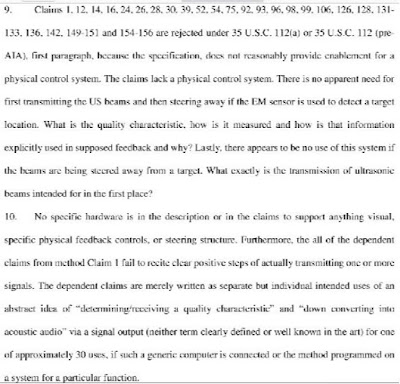Unintended Waiver
Sometimes a case has a whole slew of rejections that all
relate to a common issue or complaint by an examiner. Further, the rejections
can be somewhat sloppy, incomplete, and overlapping and create a bit of a
jumbled mess. While it may be possible (although not recommended) to write some
general remarks in response to an Office action without clearly addressing each
ground and have the examiner consider it fully responsive, when the case is on
appeal one must be very careful to address every ground of rejection in a
separate section of the brief, and in doing so address the specific
requirements of each ground of rejection.
1. A system comprising: an array of
ultrasonic emitters; an imager; a passive receiver; a microphone sensor; at
least one control system including at least one steering component and
including at least one computer processing unit configured to perform
operations including at least:
modulating at least two ultrasonic beams based on digitally formatted audio for emission from the array of ultrasonic emitters;
identifying using the imager a target location for the at least two ultrasonic beams based on detection of the passive receiver positioned at the target location;
steering using the at least one steering component each of the at least two ultrasonic beams to intersect at the target location, whereby the at least two ultrasonic beams are down-converted to acoustic audio;
detecting a quality characteristic of the acoustic audio at the target location using input from the microphone sensor positioned proximate to the target location; and
changing at least one of a direction, a frequency, or an amplitude of the at least two ultrasonic beams based on the quality characteristic of the acoustic audio detected by the microphone sensor positioned proximate to the target location.
The Office had rejected the claim as lacking written description, being unclear, omitting essential elements, being obvious, being non-statutory subject matter, and not being enabled. The appeal brief addressed each of these, but according to the PTAB did not fully address the enablement rejection. The enablement rejection was set forth as follows in the final rejection:
The PTAB reversed every other ground of rejection, but when it came to enablement, they affirmed (internal footnotes omitted):
Appellant does not present any substantive argument that the Examiner erred in rejecting the claims under 35 U.S.C. § 112, first paragraph for failing to comply with the enablement requirement. See Appeal Br. 12–15. Although Appellant quotes the Examiner’s enablement rejection, Appellant addresses it as an indefiniteness rejection. Id. As such, Appellant has waived any argument addressing the substance of the enablement rejection. 37 C.F.R. § 41.37(c)(1)(iv); Ex parte Frye, 94 USPQ2d 1072, 1075–76 (BPAI Feb. 26, 2010) (precedential). On this basis, we sustain the rejection of the claims under 35 U.S.C. § 112, first paragraph, for lack of enablement.
Looking to the appeal brief, it did have a section addressing enablement as follows:
While there may be ways forward to remedy the current state
of the case, perhaps the result might have been different if the brief would
have addressed the specific issues required for an enablement rejection, such
as undue experimentation and/or the Wands factors.
So, be careful in your appeal briefs to fully address each ground of rejection, even if the examiner simply repeats the same reasoning from different grounds. The PTAB will require a proper analysis of each ground of rejection that addresses the particular questions relevant to each ground.





